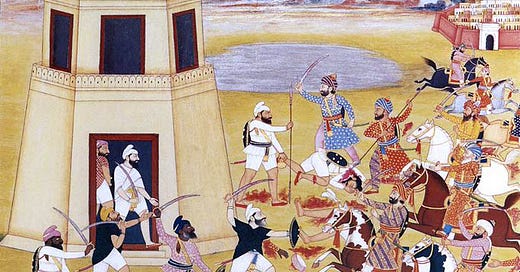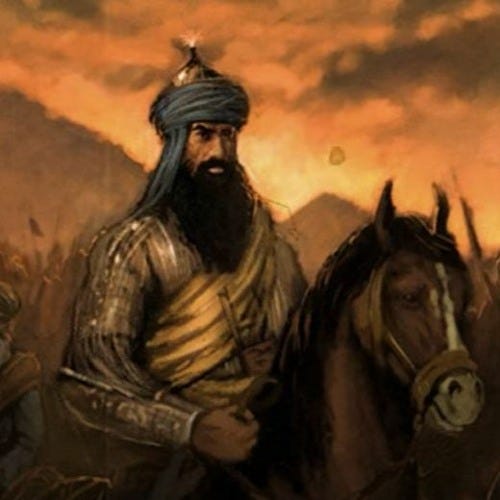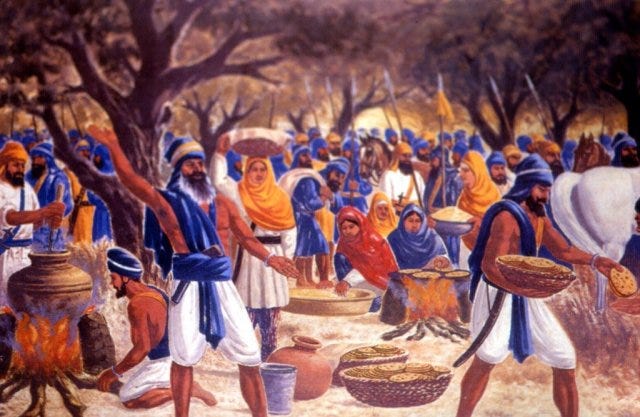Premise:
In 1708, blue-clad Sikh warriors thundered across the Punjab led by Khalsa generalissimo Banda Singh Bahadur (c.1670-c.1716). Armed to the teeth, they unleashed a calculated orgy of strategic violence to liberate Punjab from the clutches of the Hindu-Muslim combine plundering it. Joined by the Punjabi peasantry, they swept from the borders of Delhi to the outskirts of Lahore striking the fear of their Creator, Akal, in each and every heart. Essentially, they imbibed the aphorism: no better friend, no worse enemy. Young, aggressive, and fanatical in their zeal to rebuild the world through Khalsa expansionism they followed one motto that they engraved on their coins and swords: ਦੇਗ ਤੇਗ਼ ਫ਼ਤਿਹ. But whatever did they mean by this declaration?
Past Versus Present:
Just as history refracts through the historian’s mind and there can be no truly impartial rendition of the past, similarly ancient theology refracts through the modern theologian’s mind often gaining present-day nuances that tamper with the meaning and significance of the original concept. In our current postmodernist times where the past is often invalidated by imposing current overtones on it even the declaration of ਦੇਗ ਤੇਗ਼ ਫ਼ਤਿਹ has been significantly watered down to reflect a secularistic worldview that is at odds with Sikhi. In English, the declaration means: degh tegh fateh or the cauldron, sword, and victory. Put simply, victory through the cauldron and the sword. But how is this victory ever practically gained?
The Secular School:
The secularist school reduces Sikhi to an internal spirituality shorn of its religiopolitical significance and unique identity that informs its heritage. The secularists argue that degh tegh fateh simply means charity, exemplified by the cauldron, and protection, symbolized by the sword, are the pathways to victory. This worldview demands that the Khalsa be defined as some proto-global spiritual police force that only exists to feed others and protect others and this is how it gains its victory. Watered-down and often ungrammatical interpretations of Gurbani are offered to prove this perspective which echoes the same post-Nuremberg 20th century western liberalism that promised to usher in an universal Utopia with states acting as the guarantors of both sustenance and protection. The implosion of the Soviet bloc put paid to such grandiose dreams of centralized ideological systems promising to remake human society through state power. Sikh secularists, though, still have to catch-up.
The Sikh Supremacy School:
Then there are those for who only Sikhi is superior above all else and who attempt to live like their warrior-saint forefathers did in the 18th century: eschewing all political correctness and social conventions for a more Khalsa-centric dominance of other worldviews. For Sikhs who believe in the total supremacy of Sikhi, there is no higher authority in existence than the canonical Guru Granth that incorporates the injunctions of the Sikh Gurus. Herein lies the dilemma of the secularists and those who would oppose the supremacist school. If indeed there is general concurrence that there is no higher authority than the Guru Granth then why rely on modernist interpretations to comprehend it? For the Sikh supremacist, Sikh history orbits the Guru Granth and its highs and lows can only be comprehended through Gurmat.
The Ideal Sikh State:
Sikhi disallows utopianism. The Gurus were conversant with the fact that the mortal will forever be born in ignorance and will resultantly be compelled to battle with themselves to attain an enlightened state of existence. The Sikh is one who treads this path of self-battle, the Khalsa is one who has attained mastery in this conflict. Thus, the Khalsa is the higher echelon of the Sikh and is the organic representation of the Guru Granth. The Sikh theologian Bhai Gurdas (c.1551-c.1636) elaborates how Guru Nanak foresaw this ideal and started the tradition of Guruship to realize it:
ਸਿਧ ਸਾਧਿਕ ਮਿਲਿ ਜਾਗਦੇ ਕਰਿ ਸਿਵਰਾਤੀ ਜਾਤੀ ਮੇਲਾ।
The Sidhs and other recluses meet and attempt to awaken themselves by performing austerities at the Sivratri fair.
ਮਹਾਦੇਉ ਅਉਧੂਤੁ ਹੈ ਕਵਲਾਸਣਿ ਆਸਣਿ ਰਸਕੇਲਾ।
Mahadev is a recluse and is infatuated with Yogic poses, thinking they will awaken him.
ਗੋਰਖੁ ਜੋਗੀ ਜਾਗਦਾ ਗੁਰਿ ਮਾਛਿੰਦ੍ਰ ਧਰੀ ਸੁ ਧਰੇਲਾ।
The ascetic Gorakh calls himself awake after meeting his Guru Machindar, the lustful one who eloped with a concubine.
ਸਤਿਗੁਰੁ ਜਾਗਿ ਜਗਾਇਦਾ ਸਾਧਸੰਗਤਿ ਮਿਲਿ ਅੰਮ੍ਰਿਤ ਵੇਲਾ।
But only Satguru (Guru Nanak) is the true awakener who meets the Sadhsangat at the ambrosial hours.
ਨਿਜ ਘਰਿ ਤਾੜੀ ਲਾਈਅਨੁ ਅਨਹਦ ਸਬਦ ਪਿਰਮ ਰਸਖੇਲਾ।
In the divine house (Gurudwara), deep contemplation is practiced and the self enjoys immersion within the wisdom of the unspoken speech.
ਆਦਿ ਪੁਰਖ ਆਦੇਸ ਹੈ ਅਲਖ ਨਿਰੰਜਨ ਨੇਹੁ ਨ ਵੇਲਾ
The primal Being is deserving of all salutations for he is unmarked and forever existent.
ਚੇਲੇ ਤੇ ਗੁਰੁ ਗੁਰੁ ਤੇ ਚੇਲਾ ॥੧੭॥
And so from the disciple to the Guru and from Guru to the disciple.
-17:26
As Sikhs, each successive Guru tread the rigorous path of attaining enlightenment through Naam to inspire mortality to transcend itself. Sikhi differs from the false faiths in that that it emphasizes that divinity entered the mortal realm in the form of the Gurus and then lived like a common mortal to partake of their daily struggle and emphasize to them that despite the frailty of their lives, they could ascend to a higher mode of existence thus surpassing the unenlightened bestial humans. This is why the Gurus refrained from exhibiting their miraculous powers as it would segregate them from the majority humans who had no such recourse available to them. Similarly, the genuine Guru Panth Khalsa too is a collective Guru because it imbibes the Guru Granth with each member having undergone the same rigors of Naam that the progenitor Gurus underwent.
With the relationship between the Sikh Gurus, the Guru Granth, and Guru Panth established let us focus on the dynamics of the Sikh state whose constitution is in the Granth but governance in the Panth. Undeniably, Banda Singh’s central mission was to establish an embryonic but expansionist Sikh state that would allow the Khalsa to territorially anchor itself before subduing the world around it. But was this a postmodernist state in the sense that it offered everyone sustenance and protection? Superficially it may indeed seem so. But the history of Sikh statecraft shows that those who paid taxation to Sikhs and accepted their supremacy received succour. Others did not irrespective of their circumstances.
ਰਾਜ ਕਰੇਗਾ ਖਾਲਸਾ ਆਕੀ ਰਹੇ ਨਾ ਕੋਇ॥
ਖੁਆਰ ਹੋਏ ਸਭ ਮਿਲੇਂਗੇ ਬਚੇ ਸ਼ਰਨ ਜੋ ਹੋਏ॥
“The Khalsa shall reign supreme, no resistor will survive. The dishonored will unite, and only those who submit to it will remain.”
-Bhai Nand Lal, Tanakhnamah.
Thus the Khalsa as a collective of self-battling Sikhs set upon reforming the world in their own image does not aim for the creation of an utopian state but a state rooted in pragmatic Sikh values as enshrined in the Guru Granth. It brokers no resistance and only those who submit to it are allowed to remain in existence. It unites the dishonored and forms an universal assembly for the freedom of man not from external tyranny-because this is man’s own individual battle-but from the tyranny of himself. For such a Khalsa autonomy in life is an ideal more cherished than any other principle. And so in an ideal Khalsa state, independence and not reliance is the functional principle of living life.
ਆਪਣਾ ਕਾਰਜੁ ਆਪਿ ਸਵਾਰੇ ਹੋਰਨਿ ਕਾਰਜੁ ਨ ਹੋਈ ॥
ਜਿਤੁ ਕਾਰਜਿ ਸਤੁ ਸੰਤੋਖੁ ਦਇਆ ਧਰਮੁ ਹੈ ਗੁਰਮੁਖਿ ਬੂਝੈ ਕੋਈ ॥੩॥
“Resolve your own affairs yourself. We can never resolve the affairs of others. Only commit yourself to those actions that inspire truth, contentment, piety, and righteousness-this is what the rare few Gurmukhs know.”
-Guru Granth, 351.
The Degh:
In light of the above degh tegh fateh reacquires its original Gurmat meaning. Consider the following verses of the Guru Granth describing the qualities of the enlightened Gurmukh Khalsa:
ਪ੍ਰਭ ਕਉ ਸਿਮਰਹਿ ਸੇ ਧਨਵੰਤੇ ॥
ਪ੍ਰਭ ਕਉ ਸਿਮਰਹਿ ਸੇ ਪਤਿਵੰਤੇ ॥
ਪ੍ਰਭ ਕਉ ਸਿਮਰਹਿ ਸੇ ਜਨ ਪਰਵਾਨ ॥
ਪ੍ਰਭ ਕਉ ਸਿਮਰਹਿ ਸੇ ਪੁਰਖ ਪ੍ਰਧਾਨ ॥
ਪ੍ਰਭ ਕਉ ਸਿਮਰਹਿ ਸਿ ਬੇਮੁਹਤਾਜੇ ॥
ਪ੍ਰਭ ਕਉ ਸਿਮਰਹਿ ਸਿ ਸਰਬ ਕੇ ਰਾਜੇ ॥
“Those who enshrine their Master (within their hearts) are truly wealthy.
Those who enshrine their Master are truly honorable.
Those who enshrine their Master are truly acceptable (to their Master).
Those who enshrine their Master are truly the foremost among all.
Those who enshrine their Master are truly autonomous.
Those who enshrine their Master are the monarchs of all.”
-Guru Granth, 263.
The degh is indeed a cauldron. But it does not denote sustenance for all and sundry. It is a proclamation that the Khalsa is autonomous and does not rely on others for sustenance. Essentially, the Khalsa is its own succour and as a result owes no loyalty to anyone besides the Creator who is the fount of all virtue. This is the Khalsa’s superhuman declaration of selfhood. It is not reliant on any earthly power for giving it the fundamental fuel for life, for existing: sustenance. It feeds itself through its own means. It neither relies on charity and nor is it charitable itself. It liberates the unenlightened mortal to fend for himself, to become his own means of sustenance, through example as a means of liberating him. And what does true liberation imply? Autonomy in all facets of life including sustenance. The 19th-century Sikh historian Giani Gian Singh describes how the ancient Khalsa collectively donated to one donation box that provided respite to all Sikhs during the sanguinary days of the 18th-century.
“The entire Panth has one central money depository. It contains countless treasures therein. They (the Singhs) call it their Guru's treasury. All Singhs are irreproachably honest. Whatever the Singhs earn or plunder, they place in the depository without any complaints. Whether millions or pennies, everything goes in this depository which is then administered for their benefit.”
-Giani Gian Singh, Naveen Panth Prakash, vol. ii.
It is imperative to note here how the Giani emphasizes that all Singhs are irreproachably honest and place whatever they earn and loot in this central donation box rather than rely on their brethren-in-faith to feed them.
The Tegh:
The secularist and much watered-down interpretation of the Guru Granth holds that Gurmat does not enjoin violence for righteous purposes. This is born out of some non-normative worldview that the Guru Granth is just some spiritual poetry and has no social instruction beyond be good and treat others as you would have them treat you cliches. This misinterpretation also extends to the lives of the first five Gurus who are typecast, against all historical evidence, as renunciative pacifists with exigency compelling the sixth Guru to arm himself. Such a baseless misreading of Sikh theology naturally regresses tegh to protection for all and sundry. Ludicrously enough, this is all done while denying that the Guru Granth endorses force. But does it? Let us see what it actually has to say,
ਹਰਿ ਭਗਤਾ ਕਾ ਆਸਰਾ ਅਨ ਨਾਹੀ ਠਾਉ ॥
ਤਾਣੁ ਦੀਬਾਣੁ ਪਰਵਾਰ ਧਨੁ ਪ੍ਰਭ ਤੇਰਾ ਨਾਉ ॥੧॥
ਕਰਿ ਕਿਰਪਾ ਪ੍ਰਭਿ ਆਪਣੀ ਅਪਨੇ ਦਾਸ ਰਖਿ ਲੀਏ ॥
ਨਿੰਦਕ ਨਿੰਦਾ ਕਰਿ ਪਚੇ ਜਮਕਾਲਿ ਗ੍ਰਸੀਏ ॥੧॥ ਰਹਾਉ ॥
ਸੰਤਾ ਏਕੁ ਧਿਆਵਨਾ ਦੂਸਰ ਕੋ ਨਾਹਿ ॥
ਏਕਸੁ ਆਗੈ ਬੇਨਤੀ ਰਵਿਆ ਸ੍ਰਬ ਥਾਇ ॥੨॥
ਕਥਾ ਪੁਰਾਤਨ ਇਉ ਸੁਣੀ ਭਗਤਨ ਕੀ ਬਾਨੀ ॥
ਸਗਲ ਦੁਸਟ ਖੰਡ ਖੰਡ ਕੀਏ ਜਨ ਲੀਏ ਮਾਨੀ ॥੩॥
ਸਤਿ ਬਚਨ ਨਾਨਕੁ ਕਹੈ ਪਰਗਟ ਸਭ ਮਾਹਿ ॥
ਪ੍ਰਭ ਕੇ ਸੇਵਕ ਸਰਣਿ ਪ੍ਰਭ ਤਿਨ ਕਉ ਭਉ ਨਾਹਿ ॥੪॥੨੬॥੫੬॥
“The Creator is the support of all the loyalists (who tread the Creator’s path). By blessing his slaves, the Master keeps them in his presence. The traitors continue betraying and slandering until death finally overtakes them. But the seekers of the (divine) truth only ever bow to their Maker and none other. They only ever entreat the one who is all-present everywhere. I have heard the same ancient discourse from the teachings of all (your) loyalists. All foes have been shredded to bits for which your loyalists are (resultantly) honored. (Guru) Nanak utters only these words of truth that are obvious to the enlightened ones around him. The servants of the Creator are forever in the Creator’s presence who disallows fear from afflicting them.”
-Guru Granth, 815.
This verse, composed by the fifth Guru who is stereotyped as an ultra-pacifist, concisely summarizes three key points:
(a) The laws of Akal, the Creator, are higher than the laws of man.
(b) It is imperative for the loyalists of Akal to follow Akal’s laws and none other.
(c ) When the laws of Akal and laws of man conflict the loyalist adheres only to the laws of Akal and obliterates the laws of man.
What is the tegh then? The tegh is not symbolic of protecting all and sundry. Rather, it is a sign of commitment to protecting one’s own self. It is prudent to note that when Muslims abducted women to sell them in the slave markets of Afghanistan, the Khalsa rescued them if they happened to be taken through its homeland of Punjab. It never exited Punjab to rescue them in other nations. It selected to conserve itself rather than die causelessly. It also armed the victims and reoriented them towards avenging their debasement by living the Khalsa lifestyle and slaying their rapists as a means of restoring justice to society. It established Khalsa communes all over Punjab and beyond to arrest such atrocities. But it never collectively marched causelessly with nothing to strategically gain other than feel good emotions. If the Khalsa does not rely on others for sustenance, neither does it rely on them for protection. It is its own sustainer and own protector. This is what it offers the world.
Victory:
The Khalsa’s self-sufficiency and self-protection indicates its self-accountability and self-responsibility, two cornerstones of the Sikh existence. Its victory lies not in aiding others but inspiring them to stand up for themselves. The secularists, in their utopian haze, have misinterpreted this to mean needlessly sacrificing themselves for others in the name of social justice. It is not a global utopian police force or even a state builder. It is a template for rebuilding the world. As such, the true meaning of ਦੇਗ ਤੇਗ਼ ਫ਼ਤਿਹ is not the secularist wet dream its made out to be today. Rather, it is the bold proclamation of men and women who are truly autonomous and victorious because they uphold their autonomy. It is an invitation to the deserving but also a warning to detractors. The self-sufficient who are able to feed themselves are also able to protect themselves. The laws of man do not matter to them; only the laws of Akal.







This is a good article actually. Surgically obliterates the myth that the Khalsa has no relation to the Sikhi of Guru Nanak. The Khalsa is the Sikhi of Guru Nanak in action!
This is a great one- i love the turn of phrase that our government is the Panth. Not a structure, but actual select Khalsa. Not laws, but the wise judgment of the truly human.